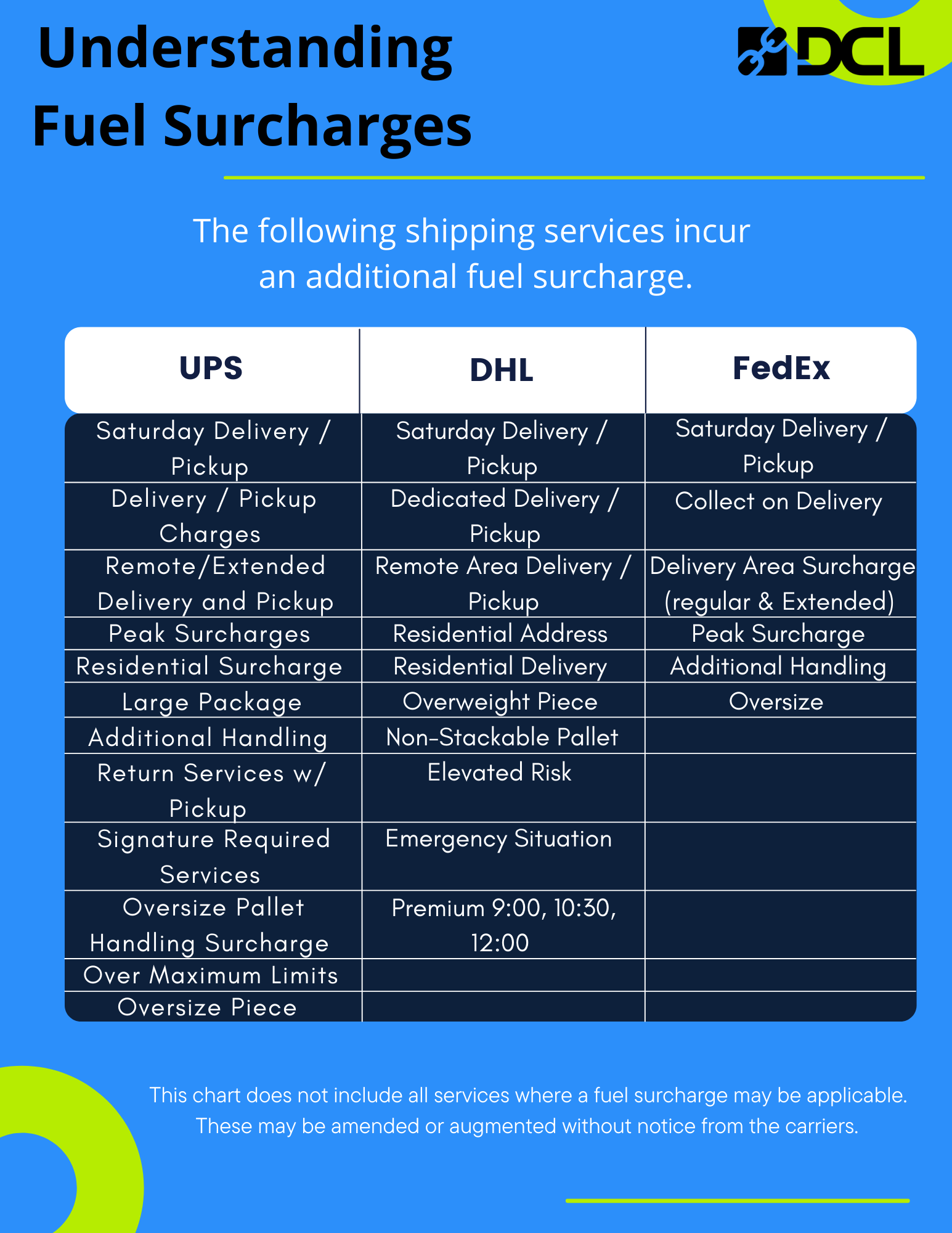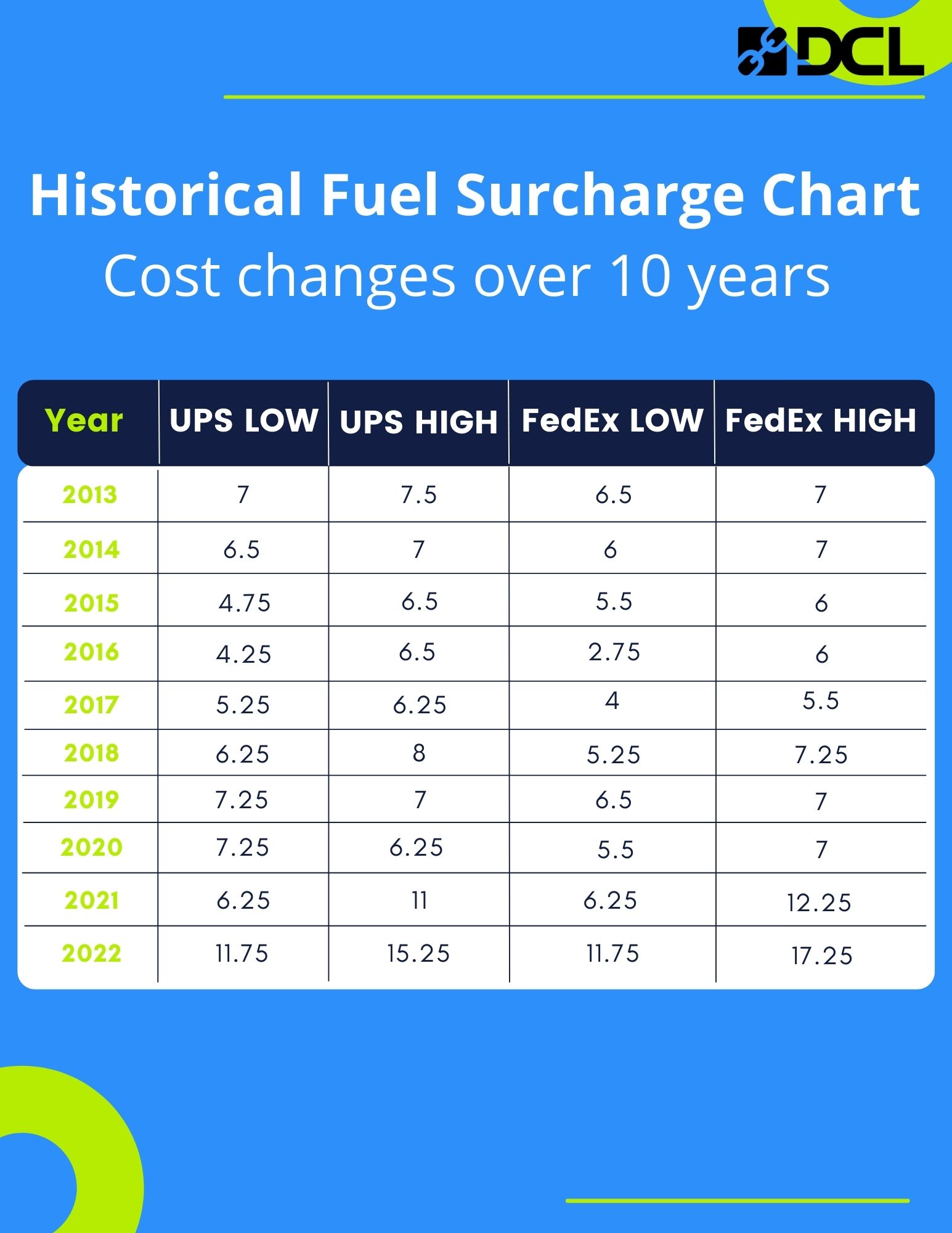
If you’re looking for fuel surcharges that will affect holiday shipping, view our chart of all peak season surcharges from the major carriers. The post also has shipping news and other rate increase information. For example, it details the UPS updated fuel rates that went into effect September 5, 2022.
Fuel can be a costly part of shipping and transportation. Because the market value of fuel fluctuates frequently, shipping companies change their fuel rates to match the market rate. That means the fuel charge you see on your shipping invoice is rarely a fixed fee or flat rate.
Shipping companies have also started adding fuel surcharges on top of their base rate, which can apply to some shipping services but not others.
What many ecommerce companies may not know is that their fuel costs are often negotiable.
Understanding how your carrier calculates their fuel rates and surcharges, is the first step in knowing if you’re overspending on this part of your overall transportation costs. Here is an overview of fuel charges and surcharges, how they are calculated, and how they affect various shipping services.
What are Fuel Surcharges and How are They Calculated?
Shipping carriers charge for fuel as a separate cost than their shipping services. But it’s not a single rate, there are many factors that go into the fuel cost you see as a line item on your shipping invoice.
Here are the main factors that go into the final fuel cost on your invoice, and how it is calculated:
1. The Cost of Fuel
Carriers determine a fuel rate based on the average industry prices or the market cost of fuel. This is so that they don’t lose money on shipments when the cost of fuel goes up and they might even profit if the cost of fuel dips.
Each carrier uses a slightly different method to calculate their base fuel rate. It’s important to understand the differences so you can find the carrier that best matches your needs and not get locked into a contract that will cost more than it should.
- UPS — fuel rate changes weekly, effective every Monday. UPS takes the average cost of fuel from the two-weeks prior to the Monday the rate goes into effect.
- FedEx — fuel rate changes weekly, effective every Monday. FedEx takes the average cost of fuel from the single week prior to the Monday the rate goes into effect.
- DHL eCommerce – fuel rate changes monthly, effective starting first of each calendar month. DHL takes the monthly rounded average from the two months prior to their effective date.
All three major carriers start with the same market price of fuel (from the national U.S. On-Highway average price for a gallon of diesel fuel as published by the U.S. Department of Energy), but because they take their average from a different period of time their base fuel rates can sometimes look quite different.

2. Fuel Surcharges
As an additional charge on top of the base fuel rate, each carrier also includes a fuel surcharge. This is calculated as a percentage of the base fuel rate (in some instances it is a flat fee, like with DHL for example) and is applied to most services.
UPS raised their fuel surcharge rate three times in the past 18 months to compensate for the rising cost of fuel. While this information is made public, it’s not easily found. Carriers might not even tell shippers directly. Be sure to ask your carrier representative about changes to your invoice frequently.
How do you know what the monetary cost of your fuel surcharge is? That requires a bit of math.
Carriers calculate their surcharges through an index-based system. There are three variables to a fuel surcharge index.
- “At Least” and “But Less Than” — these two values make up the range of the cost of fuel (gallon per mile) that will trip the surcharge percentage into effect. If the cost of fuel goes above or below these rates, the chart will be extended.
- Surcharge – listed as a percentage this is the determining factor to calculate the surcharge cost. This percentage is what changes when a carrier announces a new “fuel surcharge increase.” In recent years this has happened during peak season and other times of year to offset a rising cost of fuel or increased volume. For international shipments there is a separate surcharge percentage for both import and export. For freight rates, LTL and FTL often have different surcharge percentages.
When the base fuel rate is within the “At Least” and “But Less Than” range, the surcharge percentage in line will be applied. Here’s an example fuel index.

To calculate the surcharge cost, based on the chart above, take the percentage listed in line with the current base rate of fuel. For example, if the base rate of fuel is $2.82, the fuel surcharge rate is 10.25%, and the actual cost of the fuel surcharge will be $0.29. That means $0.29 will be applied per shipment.
Additional Resources: Look up the current fuel rates and surcharges for FedEx and UPS and DHL.
3. Additional Fuel Surcharges
Some services also incur another fuel surcharge on top of the base rate and first fuel surcharge. These services are typically ones that require more fuel to complete the delivery or pickup, for example, the remote area surcharge.
Things get complicated here because fuel surcharges are layered on top of each other. The base fuel surcharge (as laid out above) is applied to the basic services like ground delivery. If your shipments fall under any additional service categories, there will be an additional fuel surcharge added.
Most fuel surcharges apply to all transportation services, and to select additional services as well. Here is a chart of the services that incur an additional fuel surcharge. These may be amended or augmented without notice from the carriers. This chart does not include all, but many services where a fuel surcharge may be applicable.

Historical Changes to Major Carrier Fuel Surcharges
Overtime fuel surcharges change dramatically. Some major carries post their historical surcharges, but not all. Looking at the past few years and the many fluctuations illuminates the drastic increase fuel rates have taken in the past two years.

How a 3PL Can Help You Negotiate a Better Fuel Rate
As stated above, most ecommerce companies don’t realize that there are ways to negotiate their fuel rates. Working with a 3PL is a great way to let a team of experts do this for you.
An experienced 3PL will have deep relationships with each carrier and a team of transportation experts who work with carrier representatives on a weekly basis. Carriers change their rates often, having a dedicated support team to this can make a huge difference.
A 3PL will also know how to breakdown your final invoice costs. While they may be absorbed into the 3PLs services as well, they should be transparent about where each cost comes from.
If you are looking for a fulfillment provider to help you navigate your freight and shipping fees, reach out to DCL Logistics for a quote. We provide extensive services ecommerce companies looking to grow and scale.
Tags: freight





